#and londos interactions
Explore tagged Tumblr posts
Text

bad bad decisions
#babylon 5#my art#londo mollari#antono refa#😭#sorry for the evil side villain i just uh totally unexpectedly like him#and londos interactions#lol#lord refa#god tumblr destroyed the quality of this
75 notes
·
View notes
Text

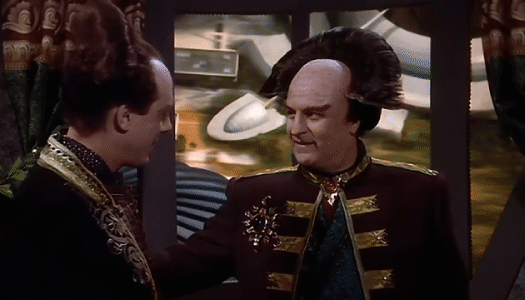
#im so sorry lmfao with these#i had to make higher quality ones oh my good look at them they are SO DISGUSTING#look at the way they look at each other. thats so fucked up#theyre literally committing terroristic acts and this is how they interact i hate hate hate hate hate hate hate this show#there is definitely something to be said abt londos body language when he gets nervous#because he does the same kind of thing to morden and cartagia#and unfortunately i just find it really endearing#its like he over compensates and tries to be over friendly or over pleasing to the other#the touching the gazes hes trying to make himself trustworthy yet vulnerable enough to either#dodge accountability or kind of go belly up at them. especially cartagia#with refa here hes peacocking. trying to assure refa that its all in londos control and he'll take care of it and that hes confident#he peacocks his power a lot with refa at the start#he wants to prove himself but its obvious refas plans start to become too much for him#londo#refa
8 notes
·
View notes
Text





TIMBER WOLF/BRIN LONDO & DAWNSTAR in LEGION OF SUPER-HEROES (1984)
#brin londo#dawnstar#legion of super heroes#I love when the legionnaires interact outside of the usual pairings 😭 they’re ALL friends#losh#*panelsandpages#legion of superheroes#timber wolf
6 notes
·
View notes
Text
I thought it might be fun to do a round up of my impressions at the end of Babylon 5 season 1.
Every character in this is great. Dr Franklin is a bit of a one-note hero but honestly that's my greatest complaint. They are all distinctive and interesting and fun.
Ivanova, of course, is particularly good and my favourite.
I'm not keen on the amount of copaganda in the way that Garibaldi is written. I feel like the vibe is supposed to be that he is a Good Man and a Good Cop who sometimes does Bad Things, but... he's not a safe person to be doing his job. This is a pity because he's a great character otherwise.
If I'm wrong about this and Garibaldi being bad at his job becomes a plot point later then I'll be much happier.
Every interaction between the ambassadors is gold, always. My husband doesn't enjoy how much that gets played for laughs given the huge consequences of their actions, but the combo of spiky personalities/high stakes/petty bickering feels very plausible to me.
Every romantic interaction has been awful. Worse than 90s Star Trek, somehow.
Probably my biggest criticism is that Babylon 5 really doesn't convince me as a home for 250,000 people. I know that there are budget factors at play but I'd buy there being 5,000 people. 10,000 at a push.
I also don't know why they needed to pick such a big number? It would all have worked just as well at small-town size.
Sinclair really needs a bigger staff.
Also I feel like if there are 5,000-10,000 people then the set-up makes sense: it's a diplomatic hub plus support staff (and inevitable underbelly). If there are 250,000 people then it feels like there's a serious democratic deficit here. Where are the Babylon 5 city council elections? Who decides when the bins get taken out?
The costumes are universally FABULOUS.
Still no explanation of why Londo sounds like a Compare the Meerkat advert and no other Centauri does. Long may this be entirely unexplained.
I can't believe season 1 is supposed to be the bad season.
It's really very good for a bad season. There were maybe one or two dull episodes. The batting average is very good.
It took me maybe 6 episodes to know that I was going to watch the lot. If you've been enjoying my thoughts and impressions, good for you, because I'm going to be here for another four seasons.
34 notes
·
View notes
Text
B5 S03e15 Interludes and Examinations previous episode - table of contents
I don't think we've heard from Ivanova's personal diary before....it's totally possible that I'm forgetting one, but still! Exciting! Hearing a personal entry isn't common on B5 iirc. I will never turn down a peek into Susan Ivanova's head.
And it's factual, bad news. The shadows have been attacking openly for ten days, randomly, all over the place. And there's an older guy looking suspicious on B5! The younger guy he's talking to I thought was Morden The Asshole at first, but that was just my moderate faceblindness tricking me, I think.
Ooooo I am excited for the return of Adira! I'm tired, very very tired, of sad genocide Londo. Let's get some character arc in here, and I liked Adira.
Wait no it is Mordan! Ah! That asshole!
There's a new alien species reaching out for aid that Sheridan isn't giving much inspiration or help to. Well, I typed too soon: he has contacts and negotiations in his toolkit of resources.
"I'm not questioning you, I'm saying you're flat wrong!"
is a great line.
Dr Franklin is definitely still on the sims, but Garibaldi should have been yelled at. The security chief has no place tyring to talk to the emergency room doctors trying to save a patient's life. Get out of there Michael Garibaldi. No room for cops in the operating room, scoot.
Morden: make your government start more wars or else Londo: I have stared death in the face and said "meh"
Elsewhere...
Garibaldi: I think you should do less legal speed and sleep more. Dr Franklin: I'm going to do more legal speed and sleep less, actually.
Delenn and Sheridan's interaction made me laugh. And perhaps it foretells of the return of Kosh to the main storyline?
This Garibaldi/Sheridan foreplay is getting intense. Garibaldi is staging a full-on intervention on the legal level. The hamfisted AA commerical is a little dull for me but could be way more annoying, as far as a storyline goes.
Morden the asshole is continuing to be an asshole, charming the caterer slash personal shopped Vir was meeting with on Londo's behalf.
lmao dr franklin. staring into the cold abyss of realizing you really really like coke.
So Sheridan slash humans see an angelic, glowing figure when they see Kosh. Which doesn't explain why the original doctor from the pilot movie was so affected by a glimpse. Me, I'd be more "huh, glowing kinda looks like an angel...the universe is weird. Stitch him up!"
"You said you wanted to teach me to fight legends? Well you're a legend too."
LEGENDARY. So legendary that's Sheridan's going to have to fight himself.
"You do not understand. But you will."
Yeah I wouldn't like to hear that after making a bargain with an inexplicable and incomprehensible higher being.
I'm too high to follow this space battle at all so it's great to hear Ivanova report that the Vorlons engaged the Shadows and were winning.
o.O they brought back Adira just long enough to have her killed before she arrived! Morden, you asshole.
Well, Lord whatshisface of Centaur who Londo half-poisoned. But Morden, ultimately, I'm sure.
Bye Adira, sorry you got fridged.
Sheridan's bargain with Kosh paid off, and now he will be alone and without Kosh's help when he goes to die on Z'ha'dum.
Which is almost as ominous as Sheridan's dream vision. Seeing Kosh, Shadows appearing and disappearing, and then his father-bit-actually-Kosh apologizing for not believing him and ...dying? Seems like if Kosh could see this coming, then he could also arrange for some like, shielding, or some other Vorlon tech for protection. But it is about time for the stakes to be raised and the mentor figure to be killed off in this hero's quest, I suppose!
The Vorlons think it's a bad idea to announce that Kosh slash a Vorlon? has died. So they're going to send a new Vorlon to replace him?? new character alert! I look forward to meeting Kosh-notKosh-Kosh.
Londo still buying Morden's shit! Londo's revenge arc is, I glumly foresee, going to include more war crimes, and continue to be sad.
Hmmm. I didn't expect Dr Franklin to resign! I'll be interested in finding out what he gets up to while he tries to do less speed.
But not in the next!
21 notes
·
View notes
Text
Babylon 5 rewatch, S1 E12: By Any Means Necessary
Is G'Kar's very perishable cargo spoo?
OH SHIT
I think this is the first time we see G'Kar engaging with his religious tradition. So the cargo isn't something frivolous at all. I wonder what a G'Kwan Eth is.
Cheap equipment and understaffing = death!
Londo is such a dick LMAO
Babylon 5 having funding problems is the least surprising thing about it, especially because of the human supremacist sentiment on Earth. Aside from the actual terrorists, I bet that the sentiment is related to government officials who don't want to fund a big human-alien peace project.
I think this is the first strike I ever saw depicted in fiction.
Okay, a G'Kwan Eth is a plant.
Lando deserves a smack in the face. But I do like seeing more specific interactions between him and G'Kar, it helps set up a lot of stuff later.
Oh hey religious diversity within an alien species.
This asshole labor negotiator--the phrase of "hostile alien governments"--this is definitely part of the home guard stuff.
Oh look at Lando's dressing gown. VERY fancy
I like the detail of G'Kar's communication device--obviously each different alien group would use different hardware, not the communicators that the B5 staff use.
I remember when I watched this the first time I was confused about why that guy was so concerned about whether the strike was illegal or not, because in my mind as a kid I only understood that strikes took place when work conditions were impossible--whether it was illegal or not wouldn't change the conditions that required the strike, therefore it being illegal wouldn't stop it. Now I understand that whether it's illegal or not has to do with what the authorities can do in response.
And Sinclair's response seemed to me the only reasonable one.
I forgot about the speed-of-light twist to the necessity of sunlight, I liked it then and I like it now.
And now, thinking of the speed of light, how is live video chat happening with Earth? Are there like, tiny data-only jump gates that are constantly open?
18 notes
·
View notes
Text
Thoughts on Shadow of the Erdtree
We may be suffering, but it's a good kind of pain! Just some notes on things like easter eggs, nods to past souls games, new lore, and other things I found enjoyable in the DLC.
Will update along as I progress (torn because I wanna know everything but I also want to savor the game/don't want it to end).
Possible spoilers under the cut:
Shadow Keep : Probably my favorite place in the DLC. It's got a hugeass library + museum! The building's entire architecture is VERY Dark Souls and it brought back good memories of going up the flying buttress (sans sniper knights). It also has its own New Londo area and pulling that lever and watching the water drain was just so satisfying.
Messmer the Impaler : Yes. Let me edge him lmao. I guess we all thought the scorched butterflies were his but he's got his own Black Pyrefly. But I think he and Melina are possibly twins like Malenia and Miquella. His Kindling description says he and his younger sister had a vision of fire. Which makes me think of Melina, who offered herself to be kindling to burn the Erdtree. But it really bummed me out that he had to be beaten a bit early/mid-game. They hyped him up as the face of the DLC (with good reason) but it felt too soon for me. This is just a personal opinion bc I fully admit to simping and just hoped for more interactions (I got his outfit tho, that will have to do).
Living Jar lore : This was truly horrifying to me and I haven't been scared shitless by lore implications (and those actual things) in a good while. The Shadow Keep basement reminded me so much of Bloodborne's Research Hall/Grand Cathedral with all those little experiments running around. Walking into Bonny Village and going into jar caves was pure nightmare fuel but I love it so much. I hope there are more item descriptions to find and add to the lore.
18 notes
·
View notes
Text
Pilgrimage and the Lands of Lothric: The Medieval Narrative in Dark Souls III
Here is the essay that got me started on my route of video game studies and digital media. I was taking a class with a medievalist professor that was talking about the ways that medieval themes and thoughts are still prevalent in the world today. She is a huge soulsborne fan so when I pitched this idea she was super into it, with this essay going on to become my grad school application essay. I hope you enjoy it!
Pilgrimage and the Lands of Lothric: The Medieval Narrative in Dark Souls III
I. Introduction
Dark Souls III is, although frequently lauded, a very opaque narrative. Little of the narrative is told to the player at any point during the thirty to forty hours of grindingly difficult roleplaying game action and adventure. What little bits of story are present, however, are delivered from sought out sources, such as non-player characters (NPCs), items descriptions, and flavor text throughout the game world, as well as inferences from the dilapidated kingdom of Lothric that the player gets to explore on their quest to “link the fire” on behalf of one of the few more friendly characters that they come across during their time in the game. In this paper I am going to summarize the general overview of the story of Dark Souls III and show that it is a modern analogue to the pilgrimage practices of the Middle Ages. In doing so, this paper strives to shed some light into the abyss that is the in-game lore plotted so masterfully by FromSoftware, the studio behind the Souls series.
II. Background
Opening up with a cinematic, Dark Souls III lays out the four bosses that the player must fight, explaining that, “In venturing north, the pilgrims discover the truth of the old words. / ‘The fire fades, and the lords go without thrones,’” [1] as part of the sixteen lines that accompany the showcase of the world and bosses before the game actually starts (Dark Souls III). From here, the game does not volunteer much other information, aside from brief sections of dialogue when interacting with the NPCs that are necessary for game progression.
As to set a baseline to draw from, then, here is a manual explanation of the main events of the game and its world: Dark Souls III cast the player as “the unkindled one,” an undead being who is awoken in response to the fading of the light of the world in order to restore, “link,” the flame and continue the current in-world epoch, the Age of Fire (Dark Souls III). Along the way, the player is tested in several environments that are central to the narrative, as FromSoftware relies heavily on the environment to form the majority of its storytelling, each of which is usually completed with the defeat of one of the games many bosses. Four of these such bosses, which the player must seek out, are called the Lords of Cinder, each of which has abandoned their duty to continue the light of the world, and therefore must be fought and their cinders brought back to rekindle the first flame. Once that is finished, the player is given a few choices based on their actions in the game in a kind of moral choice ultimately; do you link the fire, continuing the age limping along, extinguish the fire and let the next age of humanity begin, or do you usurp the fire and become a god yourself?
The world of Lothric itself begins in a sort of high citadel, The High Wall of Lothric, before the player descends into the dilapidated lands of the Undead Settlement, Road of Sacrifices, and Farron Keep and its swamp, all of which have a sort of overgrown, crumbling aesthetic of a tightly packed and mountain-locked countryside. From there, however, the player wanders through the ruined underground of the Catacombs of Carthus, a winding tunnel that eventually leads to the societies of old and the mythic city of Irithyll of the Boreal Valley and Anor Londo, where the old gods once lived. Lastly, the player descends into the depths again in search of the Profaned Capital, before returning to Lothric Castle to face off against the rulers of the land themselves, the twin princes Lothric and Lorian. The entire movement of the game is based on looping back to places that are familiar and making shortcuts between places that are safe to get quickly through dangerous areas that would otherwise be tedious and difficult to pass through separately. This whole journey is punctuated by bonfires, checkpoints where the player gets the chance to rest and level up and do all the other things that are central to gameplay mechanics. One of the most vital being the recovery of what the game calls “Estus Flasks” but are essentially healing items that hopefully keep the player from getting killed and having to reset to the last bonfire they visited (Dark Souls III).
More specifically, the world of Lothric is intentionally meant to be oppressive as the player makes their way through the course of the game. The landscape is made up of harsh cliffsides and thin pathways, ravines that lead down to bottomless pits, and overgrown roots that make almost every surface feel unstable. When there is architecture in the world, it takes on either a sort of ramshackle and dangerously leaning appearance in the case of the spaces like The Undead Settlement, where it is clear that the place may have once been a kind of pleasant village but was patched and repaired over and over again into barely standing structures. Otherwise, the architecture is grand, heavy, and old medieval styled. These are usually the places that have some additional historical importance to the game world, such as Lothric Castle, the home of the twin princes who rule the kingdom. Though even these structures are falling apart, tied to the themes of the game, and most of the locations that the player visits have long past their prime when they are visited. For example, the Cathedral of the Deep, an area once home to a legendary Lord of Cinder, is now nearly empty, with tattered cloth all over the floor and walls, as well as the central chambers all having been filled with a sort of black sludge (Dark Souls III). The pathways through these places are, in many cases, actual roads that have been left to the sands of time and have not been kept up, not dissimilar to the old Roman roads that were left behind after the collapse of the empire.
On another note, though also necessary for the background of this paper, is the term “narrative” in reference to videogames has been a subject of some debate, due to the non-linear nature that many games take in their storytelling (Ryan-Thon, 173). Dark Souls III, however, sticks to a relatively linear structure in its plot and keeps the important information in sequence. Therefore, in this instance “narrative” will serve as a good term to examine the story being experienced by the player and make it easily relatable in the context of literary pilgrimage narratives. In his chapter on game abstraction in Storyworlds across Media: Toward a Media-Conscious Narratology, Jesper Juul also suggests an alternative phrase, “fictional world” (Ryan-Thon, 173), following in the footsteps of a similar phrase used by Jan-Noël, “Storyworld” (Thon 289). While both of these are good alternatives, they will be employed here more specifically to refer to the world of Lothric that Dark Souls III is set in, as the world space itself is a core part of what makes the game a game and allows it to communicate its message.
Finally, in terms of background, there is the more formal games language that is used to describe Dark Souls III on a kind of meta level. The game is considered to be a roleplaying game (RPG) due to its elements of levelling up and encouragement of the player to approach problems in-game with a variety of different strategies. The setting invokes the traditional hallmarks of the medieval fantasy genre as well, as the player encounters knights, dragons, giants, castles, kings, and princes. With this established, invoking the Middle Ages as pretext for the storyworld (Eco, 68), a baseline understanding of the game and its tone has been established.
III. Foreground
Religious pilgrimage is almost synonymous with the Middle Ages and was an important part of the travel culture at the time. Roads themselves were recognized as being extremely valuable and were supported often by those who could afford it, especially those main thoroughfares that would take merchants, pilgrims, and general travelers across medieval European landscapes (Allen, 27). Pilgrims in particular made a core part of the necessity of roads as the quest they undertook was both holy (Osterrieth, 146) and economically beneficial for pilgrimage sites (Osterrieth, 153-4; Salonia, 3). What makes a pilgrimage distinct from other travel through the medieval landscape, however, is that they often focused on the relics and holy places of Christianity (Salonia, 3). Matteo Salonia suggests, in his article, “[The] reverence and physical journeys towards relics and saints were less theologically controversial than reverence and pilgrimages towards holy sites because of the new place assigned to the human body within Christian cosmology,” a sentiment that is mirrored in the bodily nature of the travel that would take place to visit such a relic (Salonia, 5). This is tied into a sort of Medieval Christian interest in the body, specifically the body as a means to channel spiritual energy into miracles and shows of faith (Salonia, 5). This differed from the Platonic view that had dominated before the Christian tradition, which placed the body as adversarial to the mental and spiritual pursuits of an individual (Salonia, 6).
Anne Osterrieth, in her article on pilgrimage as a personal quest, comments on the body-centric nature of the pilgrim’s movement, saying, “The pilgrim also drew pride from his capacity to undertake his task. He was becoming a seasoned traveler and derived pleasure from this new competence” (Osterrieth, 152). In popular media, which depicts pilgrims in a much more dower light, this attribution and celebration of prowess seems almost antithetical. However, Osterrieth emphasizes the pilgrim’s journey as one of death and rebirth, from the person they were who needed divinity into the person who has come in contact with divinity and is ready to advise the next on their journey (Osterrieth, 152). This shows that the person on a pilgrimage was, of course, seeking out a relic or holy place to venerate and receive blessings from, but also that along the way there is an unintended but necessary physical growth as they become a competent traveler and learn to deal with the challenges of long road travel.
This travel was far from unguided otherwise, as people consulted other travelers, maps, or guides to get them to their shrines of destination (Allen, 28). In the minds of the pilgrims, explored by Valerie Allen, the road was not always present, “we might call this [instrumental] representation of the road as means to end the default understanding of roads, in which they function as connectors between settled communities” (Allen, 33). Allen is looking at the pilgrimage narrative in the Book of Margery Kempe, which describes the travels of 15th century titular businesswoman, Margery Kempe (Allen, 27). This narrative, however, is where Allan draws the almost complete disregard of the road from, as it seems that Kempe herself did not find that part of the experience worth keeping track of in the same detail as the rest of her visits and exploits (Allan, 29).
Ritual, here, becomes a big part of the discussion of pilgrimage, which is itself inseparable from conceptions of rituals. “Ritual as a type of functional or structural mechanism to reintegrate the thoughtaction dichotomy, which may appear in the guise of a distinction between belief and behavior or any number of other homologous pairs,” is a definition of ritual put forward by Catherine M. Bell, in her work, Ritual Theory, Ritual Practice (20). She goes on to summarize that ritual is always tied to opposing forces in a culture or system of practice (Bell, 23). This provides a kind of structure that creates something of a cultural habit, something that fascinated scholar Pierre Bourdieu, is part of a kind of societal generative principal (Bourdieu, 78). Bourdieu takes this idea into a kind of forgetting of history and being left with only practice (Bourdieu, 79), which in some ways can be seen in some of the later ideas of pilgrimage to non-religious places or referring to the colonial settlers in America as “Pilgrims.” These tie into the discussion of pilgrimage as it establishes that pilgrimage as a ritual is always opposed to something else. In the case of historical pilgrimage this tension is between the safety of the village and staying in one place and the fulfillment of the journey at the end of a long and dangerous road.
IV. The Ground
Pilgrimage and Dark Souls III already share one thing in common, though debate has ensued about what role this takes in the narrative sphere (Bierger, 11), and that is the central necessity of space. It is space and travel that characterize a Pilgrim wandering medieval England, as well as the player character in Dark Souls III, embarking on their journey into the world of Lothric to link the fire. While the literal space is different, as there is the space that it takes to physically walk from place to place, there is a kind of abstracted sense of space that is present in Dark Souls III that is necessary for the nature of the story world (Ryan-Thon, 183). In this space between destination and starting point is where the pilgrim acquires their expertise and endures the hardships that will form them into the person worthy of accepting the blessings at the relic when they arrive (Osterrieth, 152). While in the game, the path works on a very similar level, having the player face challenges and gain experience to level-up their character so that they have the necessary competence when they come to face a boss like the first Lord of Cinder, the Abyss Watchers. Both the pilgrim and the player come across these various challenges, twists in the road, wild animals, other people threatening them, they also come across various moral encounters as well, such as to give aid or do favors for those they meet. In the reality of the past, this was much more literal, while in Lothric these moral actions take the form of side quests more often than not. In one example of a moral action that can be taken in the game early on in the Undead Settlement area, the player finds a woman, named Irina of Carim, trapped with a knight nearby. The player is told by the knight, “taken an interest in her, have you? Well, she's a lost cause. Couldn't even become a Fire Keeper. After I brought her all this way and got her all ready. She's beyond repair, I tell you" (Dark Souls III). To actually save her, if the player wants to, the process is pretty involved and includes gathering a whole other trail of items to get the door to Irina open. Alternatively, there is no real punishment for the player avoiding this action, much like in real life, and all further interactions and possible benefits of the NPCs are lost.
The main idea linking these two actions is the concept of The Quest, which is incredibly broad. But more specifically, the quest for contact with divinity, during which the central actor develops their own abilities in order to be ready to receive the divinity when the time comes. While this is plainly evident in the nature of the pilgrimage, in Dark Souls III the same concept applies. This is due, in-part, to the transmedial principal of minimal departure that was developed by Marie-Laure Ryan and adapted by Thon. The principal is “at work during narrative meaning-making that allows the recipients to ‘project upon these worlds everything [they] know about reality, [making] only the adjustments dictated by the text’ (Possible Worlds 51). It is worth stressing, though, that recipients do not ‘fill in the gaps’ from the actual world itself but from their actual world knowledge” according to Thon as he cites the original principal by Marie-Laure Ryan (Thon, 292). This principal allows for the game world of Dark Souls use the quest form much more naturalistically, allowing the player to take on the grand quest of their own pilgrimage through the Lands of Lothric in a mentally analogous process.
There is a pilgrimage here is part of the very core of the gameplay of Dark Souls III, as well as the narrative proper. Throughout the game, the player is told that it is their job to gather the necessary relics in order to link the flame, a process that proves an arduous journey and a game experience that FromSoftware has come to be known for. On the level of environment alone, there is a similarity here to the kind of landscape that a pilgrim might move through in medieval Europe, with its crumbling, ancient, ruins and overgrown roads. The oppressive and dark game atmosphere with the bonfires as checkpoints give a sense that would be not too dissimilar to that of a real-world pilgrim, going on an arduous journey only to find rest at a campfire by the side of the road. It is significant as well, that, in the very last segment of the game, the place that the player finally arrives at is a religious site, the city of Irithyll, where the most prominent buildings are those of churches. In this game area the player visits three, one called The Church of Yorshka, one that is unnamed but is home to the boss Pontiff Sulyvahn, and finally the grand cathedral of Anor Londo, where the gods once made their homes and is now home to Aldritch, a kind of heretical saint (Dark Souls III). It is after this point that the player must return to the starting citadel of Lothric to continue their journey.
It is also at this point of the game, as the player has made their way all around the kingdom of Lothric and even to places from the first couple of games in the Souls series, that this quest has been done before by others in the storyworld as well as by scores of other players before them. Combining this with the lack of direct story throughout the game, makes the player an agent in the meaning-making activity that the game has you go through, creating a kind of “intentionless action” (Bourdieu, 79). That is to say, with how little the game tells the player before their pilgrimage begins, the player is left to follow the game path and explore the story for themselves without fully clear intentions for what it is the in-game character is actually participating in. This is, in action, the kind of ritual repetition that leads to the unconscious repetition of the history of the players actions in the Bourdieusian sense (Bourdieu, 78).
Where the pilgrimage metaphor really comes full circle, however, is in the difficulty. It’s ironic to compare a medieval pilgrimage’s difficulty a videogame, but in its own space the Souls series stand as monoliths of difficulty. This difficulty, which is formed from a balance of timing-based combat and harsh punishments for failure, creates a kind of demand for focus. Whether the player wants to or not, the nature of the game demands that they pay full attention or risk losing hard-earned progress. This leads to, a kind of phenomenon where the player becomes more focused on the skill-based challenges and tunes out (or abstracts) for themselves the more complex elements of the game during the challenge (Ryan-Thon, 185-6). In a way not dissimilar from what Allen noticed with the Pilgrimage of Margery Kempe, where the repetitive action of travel was not as memorable as the destinations, the challenges and skill building (leveling up) being secondary to the large experiences of destinations (boss fights). Both walking for days and grinding through difficult game areas build patience in those who partake in each activity as well, becoming something of a meditative activity (Unknown, “Dark Souls is More than Just a Game”).
The moral component, while hard to measure, is an example of some micro-moral game morality throughout most of the game, much like in real life (Ryan et al, 57). However, much like the pilgrim’s ultimate quest being tied to the much more cosmically important goal of the afterlife of their soul, so is the ultimate morality of the quest in Dark Souls III, a large macro-moral choice to determine the fate of the storyworld (Ryan et al. 57). However, this is the area where Dark Souls III, much like other remakes and updated retellings of the stories of the past, adds in its own twist. The three endings of the game, usurping, letting die, or carrying on the flame, constitute a moral ending that does not present itself in the traditional stories of pilgrimage. Instead, the game asks its player at the very end of the game what they believe the best course of action is for the storyworld, one that has been limping along since the very first game in the series. This macro-moral decision is almost jarringly major in comparison to what minor interactions that the player has had up until that point and brings a sense of ultimate closure no matter what ending is taken. The game of course has additional content and gameplay to enjoy after the credits roll, but the narrative itself concludes finally in one of three ways. Each option, however, recolors the actions that the player took to get to that point, either as a would be king of humanity, a savior sacrificing themselves to keep the world going for another cycle, or as a savior in another sense, finally letting the limp and broken world fade into darkness.
V. Conclusion
From the content on the story itself, a lone character looking to keep the fire of the world burning and trekking across the land of Lothric, to the player’s experience of the game play, Dark Souls III sets itself in the same style of narrative as that of the experience of pilgrims. Both game and historic action culminating in a building of skills and triumph over adversity that many others may not be willing to undertake. Even with little motivation in a bleak and harsh world that appears stacked against almost every move that the player and their character work towards. While Dark Souls III may only be channeling this kind of mentality for the benefit of the player’s experience, it casts its spell regardless and has left a lasting impression on both individuals as well as the games industry as a whole (resulting in the Soulsborne game genre). However, more than just affecting the entertainment industry as a whole, Dark Souls III gives a mediated experience of one of the time-honored traditions that was once a massive undertaking across Christendom, calling up the past as it seeks to tell its own story about a medieval-like fantasy world, and also the unidyllic descent into ruin that every age face, both in the world of the game and outside of it. From a narratological perspective, it gives an interesting challenge to where the border between game world and narrative actually divides two different experiences. While from a medieval perspective, it gives a unique look into the kind of crumbling and uncertain side of what history used to be through player experience. And all of that is without delving into the rich optional or expanded content that was added after the original release of the game.
Bibliography
Allen, Valerie. “As the Crow Flies: Roads and Pilgrimage.” Essays in Medieval Studies 25 (2008): 27–37.
Bell, Catherine M. Ritual Theory, Ritual Practice. Oxford University Press, 2009.
Bieger, Laura. “Some Thoughts on the Spatial Forms and Practices of Storytelling.” De Gruyter 64 (2016): 11-26.
Bourdieu, Pierre. Outline of a Theory of Practice. Cambridge: Cambridge University Press, 1997.
Eco, Umberto. "Dreaming of the Middle Ages." Faith in Fakes: Travels in Hyperreality. Transl. William Weaver. 1973. London. (1998) 61-72.
Miyazaki, Hidetaka. Dark Souls 3. Bandai Namco (2016).
Osterrieth, Anne. “Medieval Pilgrimage: Society and Individual Quest.” Social Compass 36 (1989): 145-157.
Ryan, Malcolm et al, “Measuring Morality in Videogames Research.” Ethics and Information Technology 22 (2020): 55-68.
Ryan, Marie-Laure, and Thon, Jan-Noël, eds. Storyworlds across Media: Toward a Media-Conscious Narratology. Lincoln: University of Nebraska Press, 2014.
Salonia, Matteo. “The Body in Medieval Spirituality: A Rationale for Pilgrimage and the Veneration of Relics.” Interdisciplinary Journal of Research on Religion 14 (2018): 1-10.
Thon, Jan-Noël, “Transmedial Narratology Revisited: On the Intersubjective Construction of Storyworlds and the Problem of Representational Correspondence in Films, Comics, and Video Games” Narrative 25 (2017): 286-320. Unknown, “Dark Souls is More than Just a Game” GameFAQs (August 30th, 2014) https://gamefaqs.gamespot.com/boards/606312-dark-souls/69969309
[1] Quotes from in-game dialogue are sourced from https://darksouls3.wiki.fextralife.com, a website that has transcribed the text of Dark Souls III’s dialogue and other in-game text in its entirety.
#Medieval#medievalism#pilgrimage#essay#my essays#class essay#dark souls#dark souls 3#soulsborne#undergrad research#narratology#world building#video games#medieval literature
25 notes
·
View notes
Text
G’Kar: how would you describe salt to someone who’s never interacted with it if you can’t say “salty”?
Delenn: I would say salt is ionically bonded and crystalline, and to humans, is usually “sodium chloride” or “halite”.
Londo: salt has perfect cleavage.
G’Kar: …
Delenn: he’s not wrong, you know.
G’Kar: I think that’s what’s the most annoying about his statement.
#who are queue? what do queue want?#incorrect babylon 5 quote#the ambassadors™️#G’Kar#Delenn of Mir#londo mollari#source: @therighthandofvengeance#salt#sodium chloride#a little geology with today’s incorrect quote#G’Kar was trying to get to some philosophical point and Londo was trying to get to Adira
25 notes
·
View notes
Note
Anastacia of Astora for the Character Ask, please.

Sure thing! I'm glad you've been asking me about her lately 🖤🔥
First impression: I can clearly remember walking past her cell without noticing her at first when I entered Firelink and almost immediately went down to New Londo, and then getting shocked when I came back up and saw her in that cell! Instantly I felt sad for her since she couldn't speak to me, and then it just so happened that my next conversation w/ the Crestfallen Warrior was about her and... yeah. It was a real downer T_T
Impression now: Even though we don't get much dialogue from her I still ended up loving her so much! I've come up with many speculations on her backstory and can't wait to get to them in my fanfic!
Favorite moment: The final conversation you have with her where she mentions having spoken to Frampt about you linking the fire. There's a LOT to unpack in that short exchange! Firstly we now know she's able to leave her cell on her own volition (but mostly chooses not to), next that she's making use of her legs and tongue that we restored to her, and most importantly that she's on Frampt's side. Unlike him though, who wants us to succeed Lord Gwyn for the sake of preventing change in the world, Anastacia believes that this is the only way for the Undead Curse to be lifted, and so that "[she] can die human." I like this moment because it shows how complex the choices of the two endings actually are, and that both have their own benefits and perils attached to them which will affect the lives (or afterlives in this case) of the people you've come to know here.
Idea for a story: I mean technically I'm already writing one, though Anastacia's character won't start getting more development until a few more chapters in. But outside of epic novel length fics about the game itself, I'm always down to reading a story of what her life in Astora was like and what "heresy" she committed to be punished with becoming a Firekeeper against her will.
Unpopular opinion: Not really sure what opinions on her are "popular" or "unpopular," but I guess mine is that I think we need to see more enthusiastic interaction with her by the fandom. I'm disappointed that the vast majority of fanfics or fanart I see of her only ever concerns her death at Lautrec's hands, and just the general attitude of her being more of an object which moves things forward in the plot as opposed to a thinking, feeling human being (so basically the fandom treating her as Lautrec does in-game). I mean if you're all so obsessed with writing dozens of fics about Ornstein or the Nameless King, characters who have ZERO development in-game, then I don't see why y'all are shirking any headcanons and even fun AU stuff for Anastacia...
Favorite relationship: Anastacia & The Chosen Undead. I'm also down for shipping her with the Chosen Undead, but only if they're a woman ;-)
Favorite headcanon: My personal one is that her "heresy" was merely that she was caught praying to Velka. Maybe she always worshiped her, or maybe it was out of desperation to see justice be delivered in a world so devoid of it, but I feel that's the reason why Velka left us a Black Eye Orb by her corpse after she's killed.
4 notes
·
View notes
Text
I Told Sunset About You Rewatch Ep 3 Stray Thoughts
It's time for the tension episode. This is where things come to a head. Let's just go.
This boy really liked Oh-aew so much that it rewired his sense of smell. It's really incredible how much Billkin was willing to be unattractive in this show. This team understood that to be truly beautiful, there needs to be a little ugly.
I'm really glad they took time for us to see Teh thank Hoon for the plane ticket.
I forgot we started with Oh-aew in the tub. The girlies were not ready.
Of course Teh is up at 4 am for Oh, but he wouldn't get up for Tarn. That poor girl. Look at Tuty in the background watching this gay shit go down.
Teh asking Tarn to go off with his friends while they all watch silently from behind the screen is still one of the best scenes in the e fire show. Will also never get over PP making Billkin cry for accidentally hitting him too hard during the horseplay.
See, even Tarn knows that Teh is making exceptions for Oh he wouldn't make for her.
They just love letting Billkin play Teh being awkward. The cut to Oh falling behind Bas? Incredible. Bas always knew what was going on and was so powerless to do anything about it.
Teh is actively flirting and confusing everyone!
"I'll be with Bas, then," but looks directly at Teh? Both of these boys need to stop using Tarn and Bas as a way to one-up each other.
This going back and forth between them, Oh-aew? Heart wrenching.
Truly, how much money have PP and Billkin made from Lays because of this scene on the deck?
Poor Bas. Puts his heart out there and gets crushed. Oh knew what agreeing to that New Year's date would mean. At least be has enough class to let Bad down.
This couch scene is great because it almost feels like it could be from a multi-cam sitcom.
Hammock scene my beloved. Oh-aew is so brave. He breaks the subtext of all of their interactions and pushes Teh directly. Lets him know as they're literally on top of each other that Teh is the source of his confusion about Bas. He asks Teh the question in a way that doesn't let him deny it. Teh knows it's coming and pretends like he doesn't. "I think you know. You really don't? But I think you do. Or you really don't? But I do think you know?" Teh can't help but ask, "Since when?" And can only answer "I don't know." And admit his desire for closeness when Oh leans forward and pushes.
And now Skyline. It's out in the open now. They may not have moved much, but everything shifted.
Oh, Tarn. I need you and Bas to get a scene like Lennier and Vir in Babylon 5 where they commiserate about Delenn and Londo.
Oh shit Teh is wearing the shirt. It's about to go down.
I get it, Teh. Oh-aew is just so alluring. This man is on the floor inhaling the paper. Mess of his face. He is so gone.
Skyline really is undefeated. The amount of control Oh exerts over Teh with just his presence is just so incredible to watch even still three years later.
"Why do you have to think so hard about it? Forget about it. Do whatever you feel like. There's no need for an answer, if there's no answer." This is what I'm saying!! We get so caught up in the warring over labels. They're just tools to help us think about ourselves. Oh knows intrinsically that these two are drawn to each other and it's stronger than what he's ever felt for Bas. That feeling is what matters. He offers Teh the time and patience of "secret" to let him figure it out. You can see Teh instantly relax at that and try to fall back into the flirtatious studying they've been doing.
Man, what is it about Teh? If Teh tells him he can't quit, Oh always finds a way to dig deeper.
Jesus, Skyline remains undefeated.
"As promised." It gets me every time.
I tell ya. It's always queer boys and their moms.
I don't know what went wrong with the original translation scene or the final scene from this episode when they were in post, but what we got was so good from the reshoots that I legit never want to see the discarded takes.
I still can't believe they filmed this while surrounded by tourists. The translation scene is still my favorite confession in BL. Oh knew what was happening. He knows Teh is flirting through these Chinese lessons. It's absolutely incredible. It's just so much. Teh connected the series that helped him find his purpose to his feelings for Oh. Just omg.
That's right, Tuty! Regulate!! You can smell the sexual energy! Don't let nothing gay happen on your watch!!!
Notice that the leg touching begins as soon as Tuty leaves? She lost focus and now look at us.
Oh is so careful, he mentions being tired from walking before touching Teh's leg. He's giving Teh another way to ease in by framing it as normal help. But the score knows. Oh's hand on the inside of his thigh knows.
Oh's shirt literally says sunset, and Teh is wearing the branded shirt. They wanted us to know how this was really the climactic moment of the show. That's where his head is still at.
JFC Teh pushing Oh's face to say he's not ready for that. Look. I need to pause for this one. So many of my young encounters did not begin with or ever involve kissing. It's just too much. We can rub each other's legs and grope all night, but there's something about kissing when you're in the closet that makes it too much. Oh made it clear it's what he wanted, Teh couldn't give it to him, but they can still touch.
"What if there are two male protagonists?" I was holding my breath at this point in 2020.
It's the way Teh can't stop moving as he pulls Oh onto his chest. He just can't stop touching. The breathing gets heavy. We know where this is going. And then he stops at Oh's chest and the spell is broken.
The hot, bothered, and devastated look on Oh's face is the most impressive single expression I've seen in all of BL.
The silence at the end is deafening, and then we go into PP singing Skyline? I remember this week breaking us.
What an incredible episode. All of the games. All of the rituals. All of the safety valves. All of the blinders. All of it just to have Teh bail in the moment because he faced the physical reality that Oh wasn't a woman. He once again made Oh think he wasn't enough after pouring it on thick all episode. Goddamn.
22 notes
·
View notes
Text
*The following post contains spoilers fro Gundam Iron Blooded Orphans Urdr Hunt, episodes 1-22*
As a follow up to my previous post about Urdr Hunt:


Wistario Afam.
Wistario just doesn’t really….. grab me, as a protagonist. And I’m not sure why, but I do want to extrapolate a little. I like that Wistario has a solid, defined Goal, which is to win the Urdr Hunt, and use the prize money to buy and do up the Radonitsa colony.
Gjallarhorn making a play for Katya upends this - not completely mind, but it causes Wistario to pivot to protecting Katya at the expense of the Urdr hunt. This makes sense, he’s able to recover data from the Urdr hunt without directly collecting it himself since he knows and is friends with roughly 3/5 of the other participants (4/5 if we count the Zan brothers). This is a good decision, but it does still cause him some grief, since he knows he doesn’t have the resources to take on Gjallarhorn.
Then he meets Londo Bron, and makes a steadfast declaration of protection/marriage proposal to Katya. This is where he sorta loses me.
It’s not a bad choice, and I understand it’s borne out of his desire for family, which has been slowly building in the background as the series goes on. Thing is….. him and Katya haven’t really interacted other than collaborating on the Urdr Hunt. Honestly, the only person he’s interacted with enough that I would genuinely believe a proposal would be Range. So when I first heard it, I genuinely thought he was bluffing Londo, but then as things progress he’s serious about it, and I just can’t really fathom why, because they just haven’t interacted in any capacity that I feel would lead to romance. What I’m getting at is that Wistario’s wish to buy Radonitsa and do it up to improve the lives of people on Venus feels like the thing that keeps him “tethered”, I suppose. So I kinda lose him when that gets taken away. I don’t disagree or fail to understand his actions, it’s just that it’s such a big part of his personality that I struggle to parse him without it.
Part of this could be a bigger issue of certain characters not being explored enough - I like Range, Katya and Denmer, they’re all either explored enough for me to like them and understand their actions or have enough going on that I can fill in the blanks myself. But Wistario and Korunaru kind of aren’t, and this wouldn’t be an issue if they weren’t ostensibly the main characters. I like Korunaru, but she suffers because I believe her character could have been combined with Katya without losing much in the process, and I seem to recall the marketing pushing her as important.
I’d like to stress that if there’s some sort of Bio section in-game, or some extra side conversations that flesh them out then that sounds great, but I don’t have those in front of me so I can’t really account for them. Wistario’s just fairly obvious since he’s the protagonist, so he kind of needs to have a defined (though not necessarily strong) character.
However, I do rather like his design. It’s got a youth and energy to it that I think goes well with his desire to re-invigorate Venus’ economy, and his clothing’s functional without looking drab, so it’s believable that this is something he lives and works in. His childishness (at least comparatively. Honestly it comes and goes) and friendliness also illustrate that he’s a positive spirit and force for change in a negative environment (read: basically all of Post Disaster).
#gundam#ramblings#gundam ibo urdr hunt#Gundam Iron Blooded Orphans Urdr Hunt#gundam iron blooded orphans#Gundam Urdr Hunt#mobile suit Gundam#Urdr Hunt#Wistario Afam#Korunaru Kousa#Katya Inoshi
6 notes
·
View notes
Text
just thought about my disgusting rarepair refa/cartagia... oh i need it i need it so bad
#gonna push my agenda soon. gonna make the write up soon.#listen yall refa is the reason cartagia is on the throne. and they absolutely match each others freak.#'bring him back to centauri prime in chains as a gift for emperor cartagia'#says refa ans then cartagia literally does exactly that 'for londo' LIKE LIKE LIKE#refa was way too excitrd about the genocide and then cartagia threw a week long party bc of it like oh i just KNOW they were fucking nasty#and the DYNAMICS. oh my lord. the idea that they both think theyre the one in control...#refa thinks cartagia is just a silly little boy who he can do whatever he wants with#cartagia thinks refa is just another one of HIS centaurum goons that he CAN do whatever he wants with#and honestly refa would have ended up in cartagias closet if he had lasted longer SORRY.#like. the pre canon implications of their relationship too#I JUST THINK. oh i just think. my one wish is for me to have seen them interacting on screen i would have exploded and died#and also#look at how cartagia treats londo and look at how REFA treats londo#imagine cutting londo out and those two just treating EACH OTHER LIKE THAT? oh mmy lord. they were going at it like animals i just know it.
1 note
·
View note
Text
Spider-Man Read-Through 013: The War on... (ASM 93-99) P1
MASTERPOST
In this set of issues, Harry fights his addictions (to male muscles and to drugs), MJ is a floozy (good for her), and Peter doesn't have much luck (as usual).

Depicted above: Harry being confused because his beard girlfriend is seducing his crush, while Harry himself is being seduced by another dude.
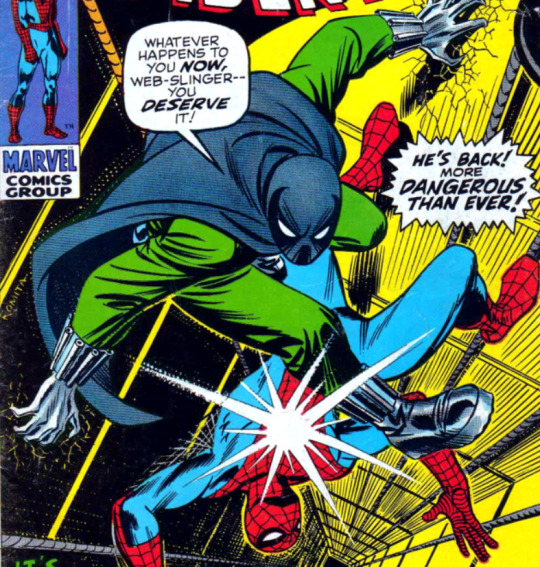
Right off the bat, I'm very sad because what the heck! The last time we saw Spidey and the Prowler interact, there wasn't any bad blood between them, far from it. Ooooh, I don't like this...
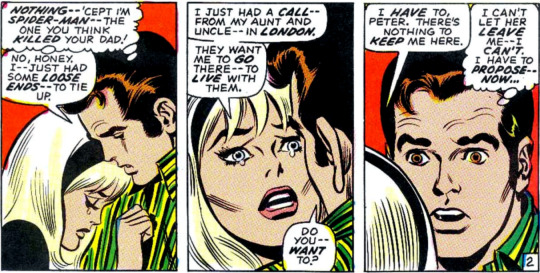
Just look at John Romita Sr.'s stunning artwork. It's not just that these panels look out of a romance story; they embody how soapy the magazine has become after Romita's takeover. I'm not surprised people were receptive to it; it offers a remarkable counterpart to the action moments. The melodrama is gripping, and both sides feed each other, similarly (if not exactly) to the spy/romance TV show "Chuck" from 2007.
Seriously though, look how handsome Peter is. Look how pulpous Gwen is. Look at their expressiveness, at their attractive features, at their posture. It's excellent artwork. Even when the stories are lackluster, the art rarely disappoints. Gorgeous. Absolutely gorgeous.
So anyway, Peter's about to use the big guns to keep Gwen here, which. *sigh* We all know what happens to her. It feels reminiscent of TASM2. I'm bittersweet.
Peter remembers he is Spidey, and recognizes he has no right to ask Gwen to stay.

By the way, I love his outfit. It's *very* different to what we've seen before. I'm not sure it really actually works, but I sure love it.
Turns out the reason the Prowler is an antagonist in this issue is that he has a hard time trusting Spidey after hearing about Captain Stacy's death. Another way the action and the melodrama influence each other! I'll accept it. I'm actually happy to know Hobie has an opinion on this.
And since Romita knows how to retain customers, he gives us some fanservice. Hell yeah. For what's worth, I still haven't seen any lady in such a getup in these comics yet. It's not the only way to show appealing stuff, of course, but it's still significant that in a magazine like Spider-Man, which seems to be aimed at boys first (if you forget Romita's arrival), you see more of the gents. Obviously, I'm simplifying this whole thing, but I had to mention it.

This batch of issues might be in two parts (or more!) since I'm spending so many screenshots gasping in admiration of the art.
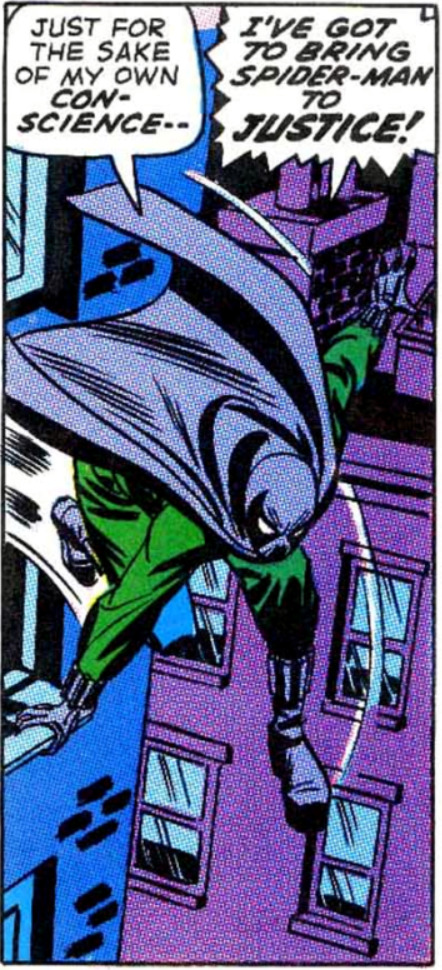


Even as though the Prowler tries to kill him, Spidey helps him break his fall by telling him to use his claws. And of course, he calls him Hobie. He undresses him (to hide his secret identity, naturally) and drops him at the nearest hospital.
Spidey goes to Gwen's to try and tell her the truth --he's absolutely determined-- but he's informed she's en route for the airport. Oof. TASM2 flashbacks once again. She's even heading for Britain too! For a different reason (family in London/studies at Oxford).
But contrary to your typical rom-com, Peter doesn't arrive in time to catch Gwen. Reality ensued.
What a great issue! I absolutely loved it.
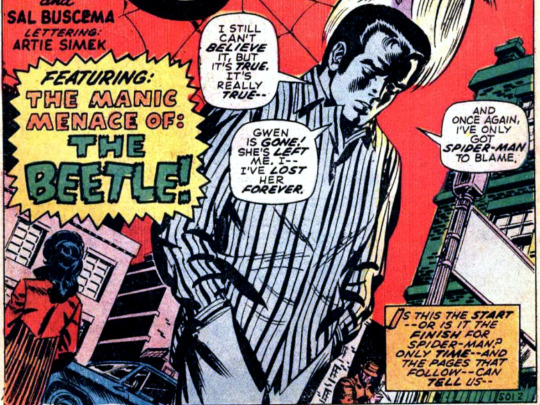
Not to sound like a broken record, but he can get it.
The first seven pages of the issue are a recap of Peter's origin story, which combined with the uninspired cover really gives off the impression the plot idea was paper-thin. At least the art is nice!
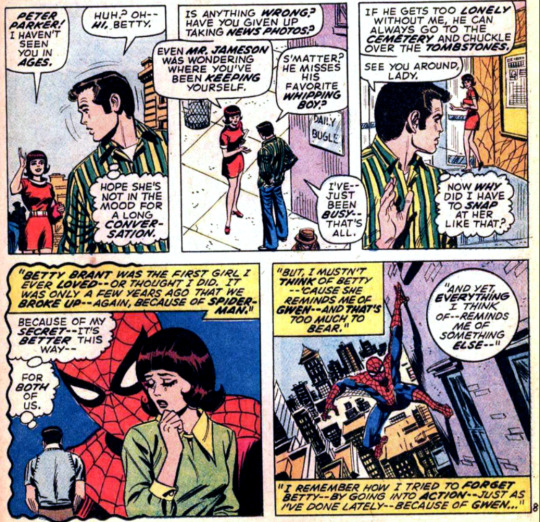
Betty is also reintroduced, but more importantly, Peter is wearing the exact same shirt as last issue's -- but different pants.
By page 15, the plot finally starts and Peter stops dwelling on the past because May's been kidnapped by the Beetle. About the most fun thing about this fight is that they crash into a public swimming pool. Audacious way to give me fanservice. I'll take it!
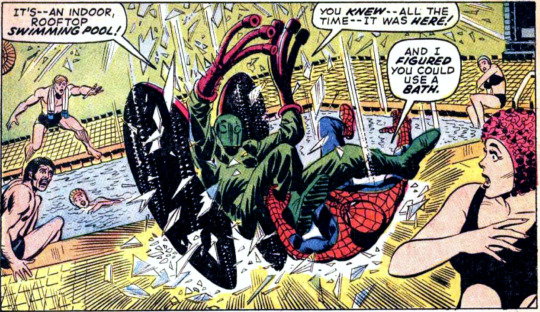
I have to assume Betty being reintroduced is a way to fuel a new love triangle. Oh well. Isn't she married to Ned Leeds? Is he going to be back too? I'd love that.
In the next issue, Spidey goes to London! He's wearing again his yellow jacket/blue pants combo that I adore so that's a good sign. Robbie proves he's the best character by telling Peter to go "work" for the Bugle in London.
Gwen is absolutely depressed when she notices that Spidey has been hunting her across continents. She just can't seem to get rid of him!
Anyway, Spidey finds the people he has to save in Big Ben. You know. A clock tower. Oof.
On page 19, Peter finally thinks about the question I had from the beginning: was he really expecting to be able to speak to Gwen, with everybody knowing Spidey's in London too?
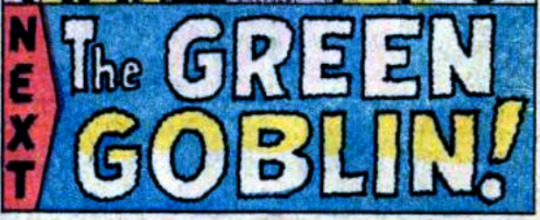
YES.
If you remember, he's been aware that Peter's Spidey for. like. maybe two years? He had amnesia, but the last time we saw him was a while ago and he wasn't amnesiac anymore. But it appears Spectacular Spider-Man #2 took place after that since Norman obviously doesn't know who Peter is.
Everybody goes to see some shows, and May and Anna are going to see Hair. I really need to watch it hahaha, it's been on my list for a small while.
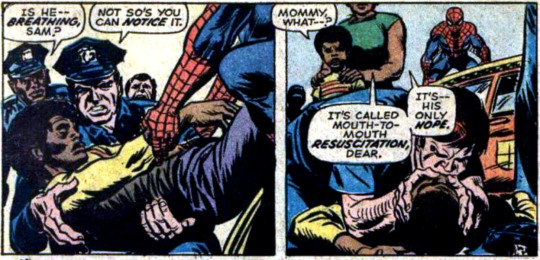
A man tries jumping off a building but Spidey saves him, and a cop kisses the man. A boy asks about it but his mom is quick to reassure him that homosexuality does not exist. It is P U R E L Y P R O F E S S I O N A L (you know, like Robbie and Stacy's interest in Spidey).
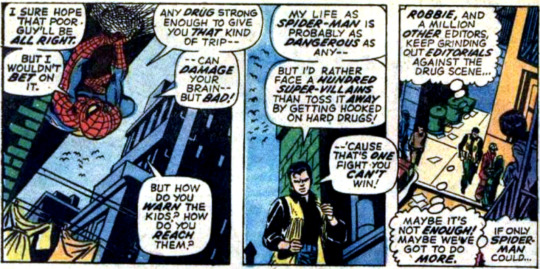
These panels dangerously sound like a kids' after special, but I appreciate the attempt. To think Peter would deal with this much more closely in a few years...
(Edit after finishing the batch: OOPS. Harry's drug problem was not a novelty in 1973.)
MJ's once again trying to make Harry jealous --and succeeding, confusing both men.
By then, Randy's totally integrated to the group (which is lovely) and he decides to call out Norman for not doing anything on the War on Drugs, which is definitely a big theme here (with the Green Goblin's persona being even compared to drugs).
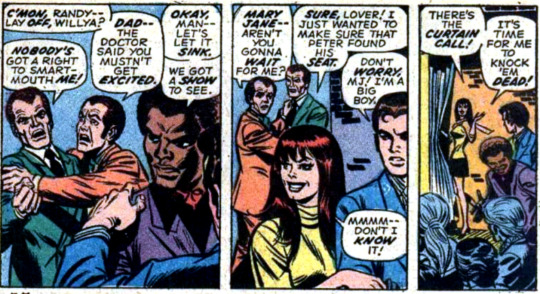
MJ also makes a dick joke and good for her.
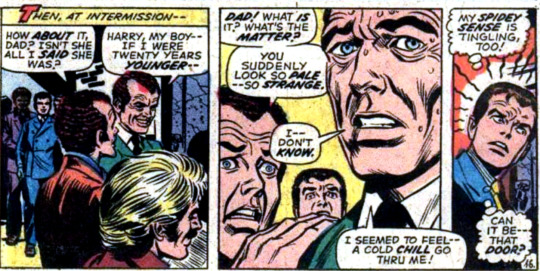
Harry tries to shoo away his homosexuality ("she's so great, right dad? huh? are you proud of me yet?") and Peter does his best concerned face.
The issue ends with MJ getting a standing ovation, the Green Goblin back and his memories fully restored. Oof. How's that war on drugs going, Pete?
In this post's last ish (#97!), Harry has been having a really hard time dealing with his buried sexuality, no thanks to Peter, who keeps hanging around, wearing not much.




Peter can't help being a condescending asshole, naturally, it's part of his character after all, but I wish he used other words in his head for Harry. It also reeks of the writers not having quite enough knowledge to handle the subject appropriately. But oh well. it was mid-1971. I suppose it comes from a good place. I just can't help but imagine Peter would try and convince me not to take ADHD meds because ~I'd get addicted to them~.
Let's just say: the writers are trying.
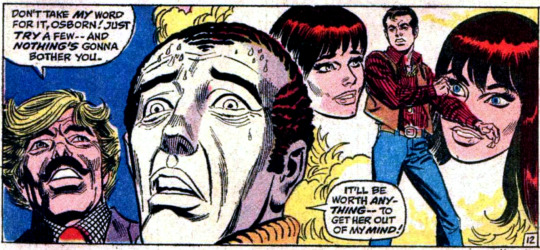
Hilariously enough, it looks like Harry's really trying to get *Peter* out of his mind.
Talking about Peter, his outfits have recently gotten quite... Bohemian. Not that I necessarily dislike it, but this is intriguing.
When Harry gets back home, Peter thinks for a moment that it's the Goblin. Ha. Ha. Ha.
It's very sad to see Harry's fall (not that he ever was really high), and what must happen happens.
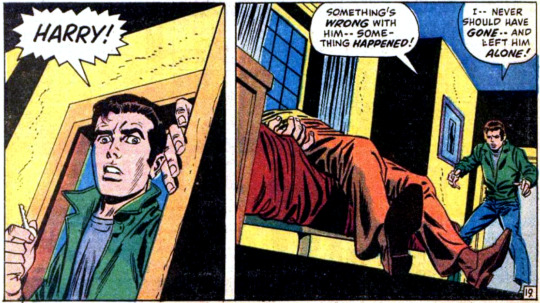
That's a nice cliffhanger to end this post on. I'm also getting tired, and I'm not sure I can put many more pictures here.
See you soon, all two of you who read my posts!
15 notes
·
View notes
Text
Interludes and Examinations!
"Londo is Londo. You never know which way he'll jump next." Idk, I feel like he's been remarkably consistent so far. You might hope he'll check his endless descent into imperialist depravity, but there really haven't been many signs of it so far.
Did the flashback show that they've made Londo's hairline recede since the first series? If so, I am so impressed. But then the hair and makeup on this show is consistently outstanding.
"I don't think you have any interest in restoring the glory of the Centauri Republic." No shit!
I don't think Garibaldi can arrest Franklin for being distracted, but he can and quite possibly should arrest him for recklessly endangering the lives of his patients.
FINALLY Sheridan is calling Kosh out! And it's not an interaction that would fill me with confidence if I were Sheridan.
Apparently Kosh subscribes to the Darth Vader school of stakeholder management.
Good job Sheridan doesn't have an undiagnosed heart condition or Kosh would be short a hero.
Despite everything I do feel genuinely sorry for Londo. Even while he is being a complete idiot.
Glad that Franklin is jumping before he does actually kill someone.
Sheridan and Delenn are remarkably mournful for the guy who had them tortured last series and who literally just assaulted Sheridan. I know he also saved Sheridan's life, but... it's a mixed bag.
11 notes
·
View notes
Text
headcanon about some parts of centauri funerary practices below yippee
The mortalzi are a subclass of the Centauri priesthood who are specifically enlisted to take care of the Centauri population after they die. They are often from multiple demographics like third or fourth sons of major Houses, criminals avoiding life sentences or lower class Centauri with nowhere else to go. The job is not glamorous and often is not one that is taken on willingly. Not only does it involve interacting with the dead but all Centauri priests are forbidden from marriage and inheriting familial properties or titles.
Mortalzi are seen as one of the lowest rungs of Centauri society. Associations with the dead historically have brought illness and death to living Centauri, and despite medical and technological advancement, the taboo remains in place. They are seen, not heard, never addressed and certainly never, ever touched. Centauri will often ignore them if they are in a room.
There is only one major requirement to be a mortalzi, which is being a man (an expectation of any class of Centaur priesthood). The mortalzi will keep their heads shaved as a symbolic form of castration to go with their lives of celibacy. The clothing of the mortalzi is simple as they keep white, hooded robes with hoods that cover their faces day in and day out. Viewing a mortalzi’s face is viewed as a death omen. Some mortalzi are telepaths, which are usually highly valuable in Centauri society. However, some Houses will relinquish young telepaths to the mortalzi if they display weak telepathy or other unrelated and undesirable traits. Those who are telepaths in the mortalzi will do deathbed readings.
When a Centauri dies the body is attended to by the mortalzi. It is cleaned and prepared for burial over a series of three days, kept in temperature controlled rooms and adorned with oils, spices, balms and other things to keep skin preserved and pliable and to prevent decomposition. Full chemical embalming is only used when a Centauri is not on Centauri Prime, to preserve the body for transport until it can come back home. Hair is prepared one final time and the bodies are then dressed. The actual act of burial depends on a Centauri’s class and place of residence.
More prominent, noble Centauri of rich Houses are kept in crypts. Especially in the Capital of the Republic. Those crypts are maintained by mortalzi (swept, flowers are changed, name plaques are polished, etc) and they are often sprawling miniature mansions. If a Centauri is disgraced by a scandal either in death or before death they are often buried on a family plot and not kept in a family crypt. Centauri who are of lower class are buried as well, with less elaborate headstones and the plots are sold individually in common graveyards. Centauri who are of no House, slaves, mortalzi, unclaimed corpses or are executed or otherwise deceased criminals are cremated.
Cremation is seen as an ultimate taboo and a disgrace to a Centauri’s body. While the dead bodies are seen as shells of a soul, those who are lucky and rich enough to leave an intact body are to be celebrated and raised higher socially in their next life. A destroyed body leaves no record of what your soul did in its past life. Cremation of bodies was also associated with mass death such as from famine or disease. Trash has also been burned historically by Centauri, and the comparison of a dead Centauri to trash is a high insult.
The mortalzi are based off of the concept of John’s final outfit in Londo’s vision in s05e02 with the long white robe, because I thought it would be nifty if that association with death/funerals was why Londo’s brain put him in that.
3 notes
·
View notes